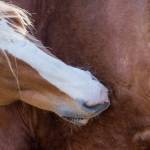Equine Gastric Ulcers and NSAID Administration

Although helpful for many painful and inflammatory conditions, nonsteroidal anti-inflammatory drugs (NSAIDs), such as phenylbutazone or “bute,” can cause gastric ulcers, especially glandular gastric ulcers. In turn, gastric ulcers result in pain, body condition changes, and poor athletic performance.
“Researchers and veterinarians once believed that NSAIDs caused gastric ulcers due to a suppression of prostaglandin production in the gastrointestinal system,” explained Kathleen Crandell, Ph.D., a nutritionist with Kentucky Equine Research (KER).
Prostaglandins constitute a group of fatty molecules that play a plethora of roles in the body, including hormone-like activities, modulating inflammation, and controlling body temperature and smooth muscle contraction, to name only a few.
In specific reference to the stomach and gastrointestinal system, prostaglandins, particularly prostaglandin E2 (PGE2):
- Stimulate bicarbonate secretion to help buffer gastric acid, which can irritate and ulcerate the lining of the stomach;
- Inhibit hydrochloric acid secretion to maintain an appropriate pH;
- Ensure microvascular blood flow to the stomach; and
- Enhance mucus production to form a protective barrier between the lining of the stomach and the stomach contents.
“Few data, if any, support the idea that a decrease in protective prostaglandin in the lining of the stomach wall caused by NSAIDs actually induces gastric ulceration,” noted Crandell.
In a recent study*, a group of Canadian researchers dove deeper into NSAID-induced gastric ulcers to attain a better understanding of the disease. A standard dose of phenylbutazone was administered to six horses for 7 days, while another six horses served as untreated controls. On days 0, 3, and 7 of the study, all horses underwent gastroscopy (direct examination of the stomach via an endoscope). The severity of gastric ulceration, if present, was recorded, biopsies of the stomach were obtained, and PGE2 levels were measured.
The researchers found:
- All horses treated with phenylbutazone developed grade ≥2 (out of 4) glandular ulceration, whereas untreated horses did not.
- Prostaglandin concentrations actually increased over time during the study period rather than decreasing as suspected.
“These data suggest that a decrease in PGE2 levels alone do not explain why horses treated with certain NSAIDs have an increased risk of gastric ulcers. Further research, as the research team indicated, is needed to help protect horses that require NSAID therapy,” Crandell concluded.
When NSAID therapy is warranted for your horse, consider protecting not only the stomach lining but also other regions of the gastrointestinal tract that can be damaged during NSAID administration.
“KER offers several supplements, including RiteTrac and the omega-3 fatty acid supplement EO-3 that help support the delicate lining of the gastrointestinal tract,” reminded Crandell.
Australian horse owners should look for these products to help maximize digestive health.
*Pedersen, S.K., A.E. Cribb, E.K. Read, D. French, and H.E. Banse. 2018. Phenylbutazone induces equine glandular gastric disease without decreasing prostaglandin E2 concentrations. Journal of Veterinary Pharmacology and Therapeutics 41(2):239-245.








